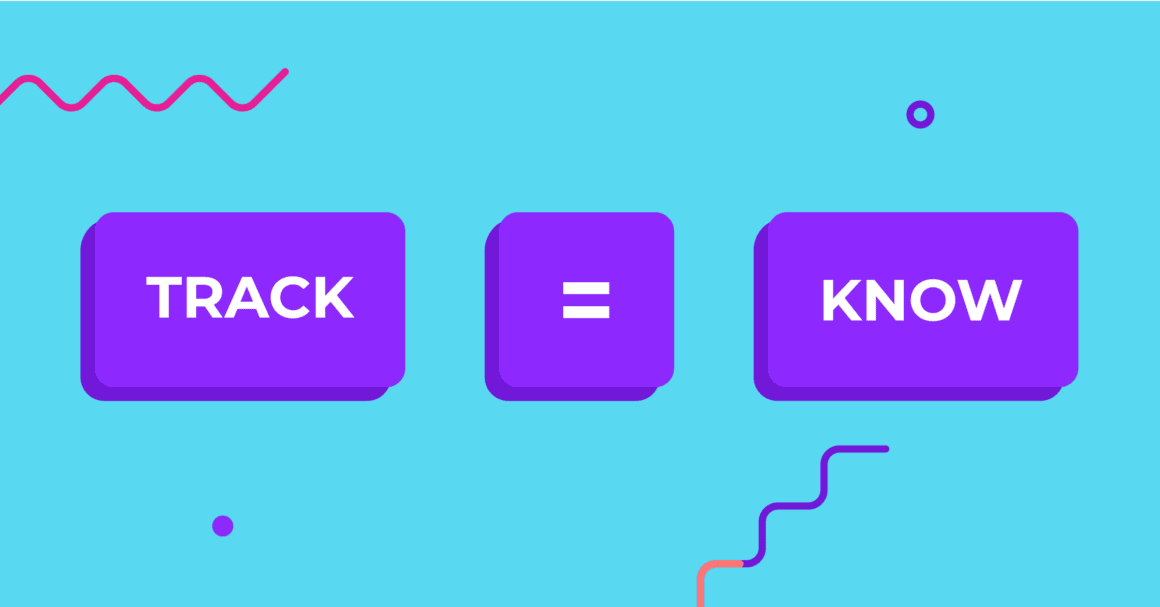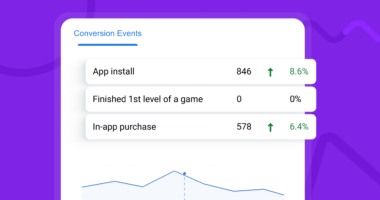Ad tracking is simply gathering information about how the money you spend on ads is working for you. It is not magical nor controversial, it’s just basic data analysis that any healthy business should perform.
Out of the many trackers that are available on the market, we believe Voluum is best suited for the majority of marketers, especially those oriented on achieving measurable goals. You don’t have to run a big company to get a dedicated ad tracker; if you spend more than $50 – $100 per day, the costs of Voluum are easily justifiable and we will prove it to you throughout this article.
Voluum is an ad tracker loved by many experienced marketers because it’s been built to solve actual and real issues that they were facing and still face today. Voluum is the complete package: we have most features while our competitors only have some.
The reasons we got to the top of our industry:
- We are big enough to have the resources to pay for the best hosting, to maintain a robust and responsive database, to develop Voluum to serve its core purpose – giving marketers’ an in-depth look into their campaign efforts.
- We originally created Voluum not as a product to sell and earn money from but as a tool to help marketers make informed decisions. The monetization came later. We still maintain close relationships with a community of our users to gather their feedback and we cherish ties with our partners that provide insights and tips on how Voluum should operate.
We don’t want to over-promise some impossible outcomes, we don’t want to sell you something you won’t benefit from or even know how to use. Voluum is a subscription-based software, we benefit if you actually stay with us for the long-term, recognize what Voluum can do, and even help us build a better product for all our customers.
This really is the case of your success being our success and vice versa.

If you are wondering what you need a tracker for, what features would be useful for you and how Voluum stacks up against other (admittedly good) trackers on the market, you are in the right place.
The case of ad tracking
You want to have your message (ad) visible on the web and there are two ways you can do that: you can wait for people to organically find you, improve your page’s quality to make it easily findable through search engines or pay for (rent) ad space from publishers.
Either way, it is good to know if your efforts are actually resulting in any changes, especially if you pay for traffic. You may have noticed that platforms where you buy traffic from have some basic information on your marketing campaigns already available. Most of them will tell you how much you have spent and how much you have earned.
On a very low level, this may be enough.
- If you run a single campaign with one or two landing pages, the complexity of such setup is so low that an ad tracker may not bring you benefits that justify its cost.
- If you are only spending $100 per month on ads, there is simply not enough room for optimization and testing with such limits.
On such a small level, you launch a campaign and hope that your intuition and initial targeting options in a traffic source will be enough.
Look at the options for analyzing traffic you have in your traffic source. You can probably see how many clicks your campaign got. But if you want to see the performance of a single lander in a given city, or how a given device type performs across your campaigns, or if you want to make any cross section analysis of data – you’re out of luck.
You also don’t have live data – most of the sources only update it every couple hours or so.
Traffic sources do have the data, they just don’t have the means to create a reporting engine and have this data easily accessible for their customers to analyse. They are in a different business. Meanwhile, ad trackers such as Voluum can get this data and allow you to have a detailed look into it.
Ad trackers also allow you to adjust the campaign flow without changing the destination link. A new link would have to go through a traffic source’s compliance again. In Voluum, it is just a click or even no click if you let its AI to decide where to direct traffic for best results.
On $1,000 ad spend level, the price for the cheapest pricing only need to increase your profits by 10% to bring you additional profit. What would you say if this pricing plan increased your profits by 300%? Is the cost of Voluum a lot in that perspective?
We are not promising magic, we are telling you what skilled marketers with the right tool can do.

How tracking may increase your earnings
Let’s get to the point. That aforementioned increased profitability can from:
- Limiting ad spend on traffic that is not performing well
- Improving parts of the campaign funnel that have been shown to be problematic
- Testing various angles to see what landing page variation works with your audience
- Segmenting your audience based on observable patterns and showing them different pages or offers that they may have higher engagement with
This is not an advanced craft that only Coca-Cola size corporations can implement, this should be an advertiser’s 101. Voluum is suitable for all sorts of digital marketers: agencies, ecommerce store owners, solo affiliates, performance marketers, in-house marketing departments. If you run ads for health insurance, fishing rods, or toy cars for yourself or your clients, you should apply these techniques.
The digital world offers possibilities that are not available to brick-and-mortar store owners: the measurability, the instant access to data. If you want just brand exposure, you can launch your ad to everybody, pay for that and be happy. But if you want concrete results – transactions, leads, app installs, newsletter signups – you should optimize your campaign funnel toward that goal.
How? Simple. You look at the data to look for answers. Here are some examples:
💡 Your conversion rate is good, number of visits is fine, but you are just not earning enough and CTR is very low.
This means that your ad is ok (people click it, hence the good number of visits) and your offer is fine, since people are converting. The weak link in the chain is a landing page with low CTR (click-through rate that shows how many people visit the page vs how many click the CTA button to go to the offer).
💡 All the visit statistics look healthy but your costs are eating into your profitability.
This may mean that you should examine your traffic to see which parts of your audience perform well and which don’t. Once you find out, exclude the latter ones from your targeting.
💡 You get tons of visits but few conversions and the traffic source charges you a lot.
Could it be bot traffic? Maybe a large portion of this traffic came from a narrow range of IP addresses or even a single address, or from a device that used an old operating system (here’s a tip: don’t buy traffic from Android version 6 and lower, nobody uses these devices anymore and they are almost 100% bots). A good tracker has tools that let you verify the quality of traffic.
Voluum features that help you be successful
The most important part of every tracker is tracking.
Voluum adopted the philosophy of having the most reliable tracker on the market. This approach puts core functionalities first. In practice, our teams are working hard to keep Voluum alive and we have had 100% server uptime since 2013. Think about all other online services that you use and have definitely had at least a few outages in the last decade. Giants like Facebook, Twitter or YouTube have been down – but we have continuously been operating because we know your traffic is everything.
Other trackers require either you to maintain servers (self-hosted ones) or use a rented server space that from time to time may become unavailable. We provide you the best server quality money can buy. In short: if the day ever comes that we are down, the whole Internet is down.
Tracking
Tracking is the way of collecting data. Voluum offers different tracking methods that serve all use cases and all personas.

Who Voluum can serve:
- Media buyers using:
- Google Ads or Facebook ads / Meta – They can be used tp market third-party or their own offers. Conversions are reported via postback and optionally passed to Facebook or Google through Voluum.
- Native traffic sources like Taboola, Outbrain, MGID – The goal is to thoroughly test the campaign funnel to optimize it for media buyer’s clients.
- Push or Pop traffic sources – They are most often used to advertise affiliate offers.
- Traffic arbitrage – Resell traffic to make money on price differences or use this traffic to double qualify visitors and advertise highly specific offers.
- Search traffic – Can be sued to advertise your own business, ecommerce products or various services that fit a specific niche.
- Solo advertisers that advertise 3rd party (affiliate) offers. They have an offer page that cannot be edited, conversions are reported via postback.
- Agencies or in-house marketing departments that advertise their client’s or their own offer. The offer page is editable, the ads are often published on Google or Facebook, conversions reported via Voluum pixel.
- Ecommerce store owners that use paid and/or organic traffic for their store. They track organic traffic and may use a solution such as Elevar to capture all conversions coming from their Shopify-powered store.
- Mobile marketers that advertise their app on the web and want to track in-app events. Characteristics: Editable offer, various advertising channels, in-app events tracked by MMP (Mobile Measurement Partner) such as AppsFlyer.
- In-house and performance marketers that are focused on achieving concrete and measurable goals.
The combination of the right tracking method and well-though-out features makes Voluum a versatile tool that can support almost all use scenarios. What’s more, Voluum’s wide API access allows you to treat it as a backend engine to your own custom solution. More on Voluum API later on.
Tracking methods
There are two tracking methods commonly used in the industry, which are also supported by Voluum:
- S2S (server to server) tracking, where a visitor goes through a redirect through a tracking domain. The tracker then records an event with all accompanying data and redirects a visitor again toward the right destination.
- Pixel tracking, where a special script (sometimes referred to as ‘pixel’ or ‘tag’) sends information to a tracker with visit info upon page load and the visitor goes to the destination directly.
Large players like Google can also pass information between their own properties using API integrations (for example, between Google Tag Manager and Google Analytics). We are hardly comparable to Google in size but we employ similar tech to communicate with most popular traffic sources (including Google or Facebook). More on Voluum integrations later.
For now, the important thing is to know each tracking method’s strengths, weaknesses and applications.
S2S tracking
Considered to be the easiest to implement and definitely the oldest, this tracking method is great for situations where you need to pass information between various platforms.
The main use case is affiliate marketing, where a marketer gets (buys) traffic from one platform and sends it to an offer on another platform, sometimes through a landing page that they set up by themselves.
The redirect method does not require editing a web page’s code (something that affiliate networks don’t allow you to do) and allows for altering the course of a visitor journey on the fly. So, when a visitor clicks an ad and goes through Voluum’s domain, Voluum can change where the visitor goes using rule-based paths, weights or AI. This enables truly complex campaign funnels.
Where this method falls short is compliance with some big platforms, like Google or Facebook, which especially don’t like the situation where they are not sure where you send visitors to. They approve your website and want to be sure that this is the only website a visitor will see. Rotating pages or changing the destination based on visitor’s characteristics is off the table for them.
The other downside is an added delay to the visitor journey (which can be especially visible with slow Internet connection) and decreased trust: users may be deterred by the redirect, which is visible in a web browser’s address bar. But don’t be overly concerned with delays – our redirect speed test demonstrates how small of an impact this method has on the performance of a typical campaign funnel.
For those cases, a direct method of tracking was designed.
Pixel tracking
This method of tracking uses scripts implemented on a destination page to send information to a tracker. For this method to work, you obviously need edit rights over the page, which excludes offers from affiliate networks but is perfect for offer owners, agencies, ecommerce store owners and so on.
Because of the way this method works, you cannot use any path altering techniques, since the script is activated after the visitor reaches the page. So no rule-based paths, weights or AI.
The upsides include compliance with big ad networks and faster campaign funnels.
The big concern for advertisers is the 3rd party cookie block that will be introduced in the world’s most popular web browser – Chrome – in 2024, provided that Google finds a suitable alternative.
So, how do these tracking methods stack up against the blocked 3rd party cookies?
What you need to know is that the redirect method uses cookies only as backup and can be set up to use 1st party cookies only (you just need to use the same domain for tracking and hosting your pages; in this case Voluum cookies will be treated as 1st party), while Voluum direct tracking uses both 1st and 3rd party cookies at the same time. This means that with Voluum, your campaigns are already future-proofed. More information can be found in this detailed article about tracking and cookies.
The seemingly far-off 2024 date of phasing out cookies shouldn’t make you too comfortable. Many web browsers, including Safari, already block 3rd party cookies. And the thing is that everybody still uses them – even Google and Facebook. They use their proprietary pixel technology to report events and conversions. But thanks to Voluum’s adaptive tracking technology, you can advertise on these platforms and not worry about losing clicks due to this block.
Tracking after iOS 14.5 update
The infamous iOS 14.5 update didn’t affect tracking the tracking Voluum offers. It caused problems for platforms such as Facebook, because it blocked the default access to IDFA – a unique advertiser identifier assigned to all Apple devices. Now, Facebook has to ask for permission to access it and, as you may suspect,- get denided access very often.
But Voluum doesn’t need the IDFA to fulfill its tracking. Lack of access to IDFA may cause problems for your MMPs that need it to track app installs or in-app activities. If you don’t do that, you can track iOS 14.5 and above devices safely with Voluum.
To learn more, we’ve prepared a detailed guide about the effect of the iOS 14.5 update on advertisers.
First-touch attribution
The direct tracking script can be modified to follow the first-touch model. The script will check if a visitor has clicked an ad before and if so, the visit will be attributed to the original campaign and the subsequent conversion will be marked as ‘returning’. This enables offer owners or ecommerce marketers to track a visitor’s lifetime value (LTV) more correctly. The first-touch attribution is a part of Voluum Managed Service.
Conversion Tracking
Similar tracking methods cover conversion tracking. A conversion is any event valuable from the perspective of the offer owner, performance marketers, agencies etc. The two methods for tracking conversions are:
- Postback URL, which is a HTTP request generated by a platform that hosts offers (affiliate network)
- Conversion pixel, which is a script that makes a request to a tracker when a page that is displayed immediately after generating a conversion (so called ‘Thank You’ page) is loaded.
The gist of conversion tracking is that postbacks are almost solely used by affiliate networks, because it cannot give an offer page edit access to all its advertisers. Postbacks are fast and reliable and the only downside is that they require a dedicated solution capable of firing them. Building such a thing is not easy, hence postbacks are not used by single offer owners or even agencies.
For all the cases where postbacks cannot be implemented, advertisers can use a conversion tracking script. This requires editing a ‘Thank You’ page’s code.
Pixels are commonly used in the industry for reporting conversions: Google, Facebook, TikTok and others use them to track conversions. The problem is that their pixels use 3rd party cookies to store click IDs. Voluum’s direct tracking scripts use both 1st and 3rd party cookies and the Voluum conversion tracking script can read the click ID from a 1st party cookie. This all means that when you employ Voluum, your data will be more accurate than just relying on these big platforms.

The last thing worth mentioning here is that with Voluum, you can even report conversions back to Google or Facebook that were registered using postbacks. To put it another way: Voluum makes affiliate marketing possible and profitable on Google or Facebook.
Normally you wouldn’t have an option to connect postbacks sent by an affiliate network with Facebook pixels. Voluum can translate these conversion tracking mechanisms and feed the big ad networks with data to enable their optimization algorithms to do their work.
Conversion attribution and duplication protection
Recording conversions does not provide the full picture – to fully connect all the dots, advertisers need to correctly attribute a conversion to an original visit. This requires properly handling the click ID, a unique identifier of each click and a good de-duplication mechanism preventing false conversions in your reporting.
Voluum has it all to keep your data consistent and actual. It rejects conversions with repeating or false click Ids (unless you change this behavior in the settings). Many trackers don’t have such mechanisms, they don’t sanitize data and without this, the trust in data is gone.
Mapping customer journey
Conversion attribution is essential for one of the main ways ecommerce store owners especially look at data. Voluum reports are built in a way that can show all events connected with a concrete click ID or all events that lead to the specific conversion. More specifically, with Voluum you can:
- Record user-generated events across multiple sites
- Attribute the right conversions to the original click
- View all events related to the original click
We have a whole separate article on customer journey mapping with Voluum.
Registering conversions without a click ID
Although in most cases you would want click IDs to be used for verifying conversions, there are some cases where it makes sense to register a conversion without submitting a click ID in Voluum. These cases include:
- Offline conversions
- Conversions that occurred in-app after the iOS 14.5 update (as conversions are handled by Apple, the click ID cannot be passed correctly from an MMP to Voluum).
In the above cases, an advertiser can use a fallback mechanism that uses campaign ID for verification purposes. What you lose in return is conversion attribution – a conversion will be tied to a campaign but not to a specific visit. More information can be found in the relevant documentation about registering conversions without click ID,
Live data with granular reporting
Once you’ve recorded your data, you need to have flexible means of analyzing it. As we have mentioned before, traffic platforms also have this data, they just don’t show it to you. The reason is simple: having a database that can fetch mountains of data on request and a solution to display this data in various configurations is very costly.
Each recorded event comes with over 30 data points attached to it. Combine it with the millions of clicks Voluum receives each day and you have a rough idea of the amount of pressure this puts on our servers.
Voluum records and presents live data, which may sound obvious until you realize that even some of the biggest ad networks present you with old data, updating it only every several hours. In Voluum, a visit, click or a conversion is visible seconds after it occurs – and you can test it for yourself by activating the campaign URL of your campaign!
Voluum offers you two ways of diving into the data: grouping up to four options (which displays all data matching selected group options) and drill-down up to seven levels (which allows you to look into all data related to a specific element).
Because of this, you can create extensive and rich reports to see:
- Performance of your offers in specific cities
- How your landing pages perform on mobile vs desktop devices
- What time of day or which day of the week brings you most traffic
This is just a glimpse of what you can get with the 30 data points and information sent from your traffic source in custom variables. The possibilities are almost endless and the answers you uncover only depend on the questions you ask.
UA string reduction
The data points obtained by Voluum are passed on in the User Agent – a string of data attached to the request URL. This contains information designed to make browsing a seamless experience. When a visitor reaches a page, the web browser communicates this information to the server (which includes browser type and version, device type and so on) so the server can send the most appropriate version of the page, in the correct language version, and format.
Google however decided to update a long-lasting tech yet again by reducing the amount of information in the UA string to prevent fingerprinting identification. This noble initiative could cause problems for advertisers that rely on detailed information passed in UA.
The good news is that Voluum is already compatible with an alternative – Client Hints. Depending on what’s available, it will fetch data either from UA or CH to get the best results and maintain the same level of detail as before. More information is provided in our article about how User Agent and Client Hints work.
API access
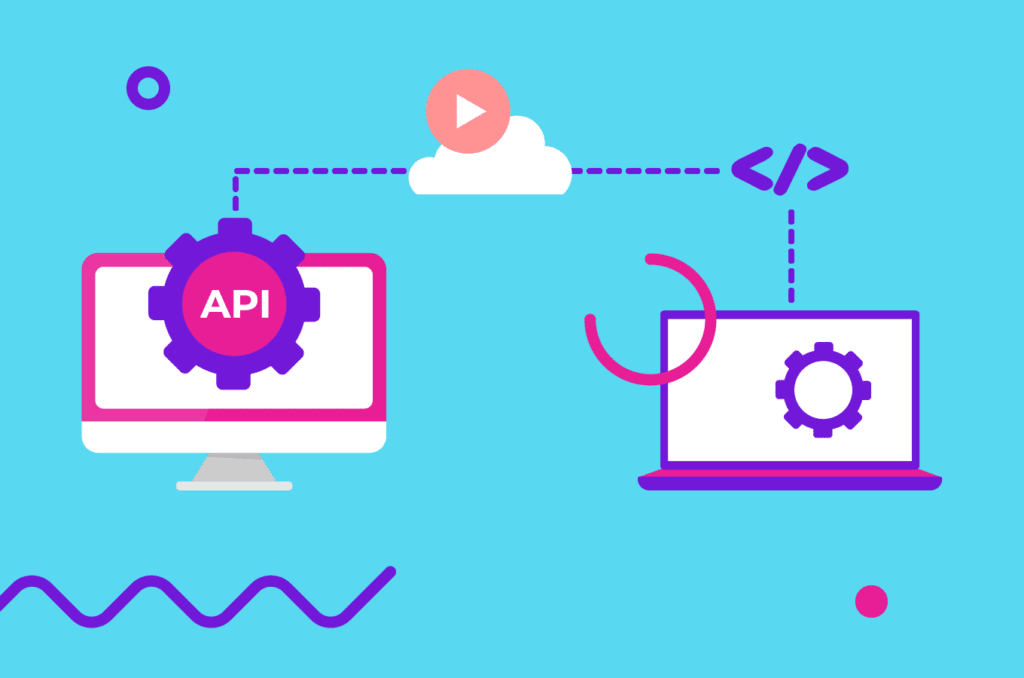
API is a way different platforms can communicate with each other. When connected via API (also called an API integration), they can exchange information or even control their various resources.
Advertisers can leverage open API access to further support their more complex and unusual use cases with their custom-built solutions. Or connect other existing systems with a tracker to feed their CRMs or similar platforms with data.
Voluum has been built around the idea of wide API access. In fact, what you can do in UI an be done with API requests. To put it in other words: each action in Voluum panel is an API request. This includes:
- Fetch data
- Create entities
- Create reports
- And so on.
Voluum exposes a standard REST-type API and you can learn more about functions, commands, and even test them on our web page dedicated to API access.
What you should know is that Voluum’s core strength: robust database is easily accessible with minimum technical knowledge required.
API also enabled the team behind Voluum to develop Voluum’s most outstanding feature – Automizer.
Voluum Automizer and Auto-Rules
The Voluum team has been working hard to build an API integration and automation module called Automizer. It allows API integrations with popular traffic sources and platforms (the complete list is available here) and a few affiliate networks.
Why integrations are important
‘Integration’ is the buzzword of the industry for good reason. Passing information between platforms or stakeholders makes the industry work.
API integrations with traffic sources unlock a whole new level of advertising. Not only do they allow for 3rd party app integrations but also power Voluum’s in-house integration module – Automizer.
Automizer is not a magic box full of algorithms that is trying to do media buyer’s work. Think of it mainly as a safety net and facilitation of your work that is possible because of integrations.
Cost synchronization
The first thing that Automizer brings to the table is cost synchronization. By default, traffic sources pass this data using the ‘cost’ token. Tracking tokens are attached to the campaign URL to pass information such as cost, placement name, or campaign ID.
In an ideal scenario, when an advertiser clicks an ad, you should get cost information along with all other visit information. The problem is that, as weird as it is, many traffic sources don’t support a dedicated ‘cost’ token. They can pass you all other information but not this.
This may be due to the fact that calculating final cost for each click may be difficult to do on the fly.
In some other cases, cost data may be lost if a visitor’s browser cuts a very long campaign URL.
The solution to problems with accurate cost tracking is passing cost data via API. Depending on an integration, cost data may be synchronized between a traffic source platform and Voluum on the campaign level or even more granularly. No ‘cost’ token is necessary. This means:
- No complex setup
- No risk of losing this data if request URL is shortened
- Cost tracking possible even for traffic sources that don’t support this token
Campaign management
Integrations allow marketers to control their campaigns from Voluum. You don’t need to log in to a traffic source platform to pause a campaign, you can do this straight from Voluum’s reports, when looking at a given campaign’s performance.
What you can do with campaigns differs between integrated traffic sources but in most you can do the following things:
- Pause and resume campaigns or placements
- Check the status of a campaign
- Change bids for campaigns or placements.
You can control campaigns in the ‘Actions’, ‘Status’ or ‘Bid’ columns.
Auto-rules
Auto-rules is another way you can control your campaigns but instead of manual clicks, actions are launched when set conditions are met.
Auto-rules use ‘if/then’ logic to support event complex automation scenarios. The list of available actions is as follows:
- Pause or resume
- Dayparting
- Mark with icon
- Add placement name to list
- Send alert
- Change bid
Voluum checks for launch conditions in a set time frame to decide whether it should start an action.
Auto-rule examples
👉🏻 Rule 1: Alert
You can get alerts by email, within the Voluum panel, or a push notification (if you have the Voluum mobile app installed) when something unusual happens, for example, the number of conversions drops sharply in the last three hours.
Benefit: This rule allows you to react quickly and fix your campaign before you burn away your ad dollars.
👉🏻 Rule 2: Create a list of good or bad placements
You can set Voluum to automatically populate a list with placement names that didn’t get much traffic or brought a lot of traffic and conversions. You can then create another rule that will only allow traffic from or block all traffic from placements from this list.
Benefit: You can make your future campaigns more profitable by using what you’ve learnt from previous campaigns. Additionally, some traffic sources don’t allow whitelist campaigns and Voluum Automizer makes them possible with this rule.
👉🏻 Rule 3: Mark profitable offers or placements
This adds a colorful icon, called markers, to campaigns, offers or placements that meet certain criteria.
Available markers:
Benefit: Using markers makes Voluum reports more readable at glance.
👉🏻 Rule 4: Pause campaigns or placements with no traffic
You can pause whole campaigns or specific placements if they don’t bring enough profit or traffic within a certain time frame or if their performance drops sharply.
Benefit: You don’t have to waste money on unprofitable campaigns as they are stopped automatically even when you’re away from the computer.
👉🏻 Rule 5: Click cap
You can limit the number of clicks (activations of CTA on a landing page) to a certain set number and pause a campaign once the limit is reached.
Benefit: Test your landing pages efficiently without spending too much money.
Anti-Fraud Kit
Fraud still makes up a significant portion of Internet traffic. While things overall look better than they were a few years ago and traffic source companies at least try to filter out or not charge you for fraud traffic, it still may cost you money and corrupt your data.
As we have summarized the situation in our A-Z guide to ad fraud and bot traffic, bots are a problem but they are a manageable problem. Voluum has means to manage it with Anti-Fraud Kit.
This is a set of tools designed to detect and act upon potentially fraudulent traffic. You have the metrics that look for potentially non-human origins of traffic (for example, frequent or fast clickers, library robots, data center IPs), Honeypot mechanism (it puts an invisible link that can be scanned and clicked only by bots), or IP/UA blocking solution.
If traffic characteristics match at least one metric, such traffic is marked as suspicious. You can then block it from buying in your traffic source (for example, block traffic from old device types or exotic locations) or re-route it using rule-based paths in Voluum to protect your reputation in an affiliate network.
Remember also that Voluum filters out known bots (such as Google bot) from stats for free by default but it does not block them in order not do jeopardize your campaigns.
Rule-Based paths
Data points that accompany each event can be used to segment your traffic and send it to different locations based on set characteristics. Paths are executed in a customizable order and the traffic that didn’t match criteria from any rule-based path goes to the default path.
Some example rules:
- Showing different landing pages to iPhone and Android users.
- Showing different message to non-unique (returning users)
- Displaying different language versions of a landing page based on the language of the visitor
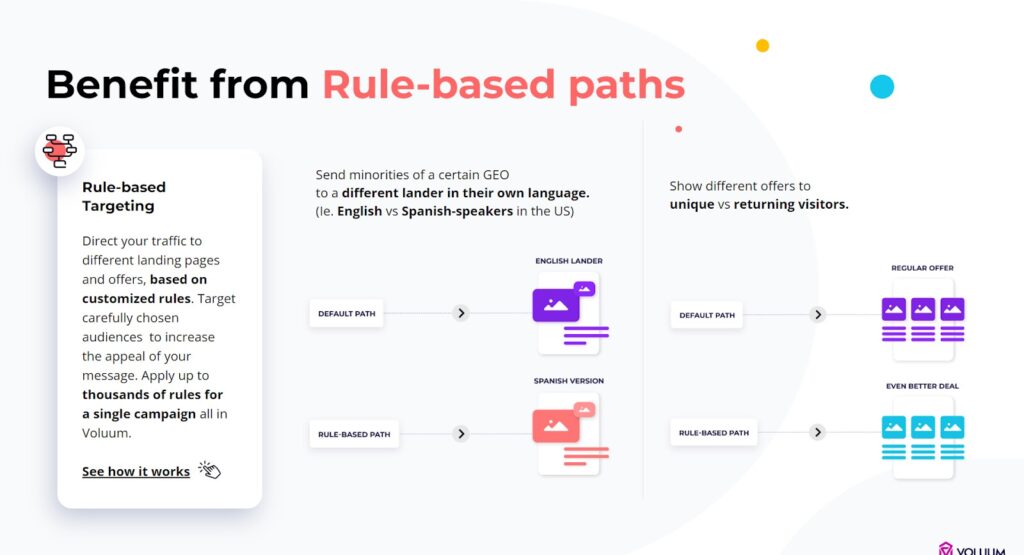
Each rule-based path, apart from a defining rule, contains one or more offers and (optionally) one or more landers with traffic distribution that can be adjusted manually with weights or automatically with Traffic Distribution AI.
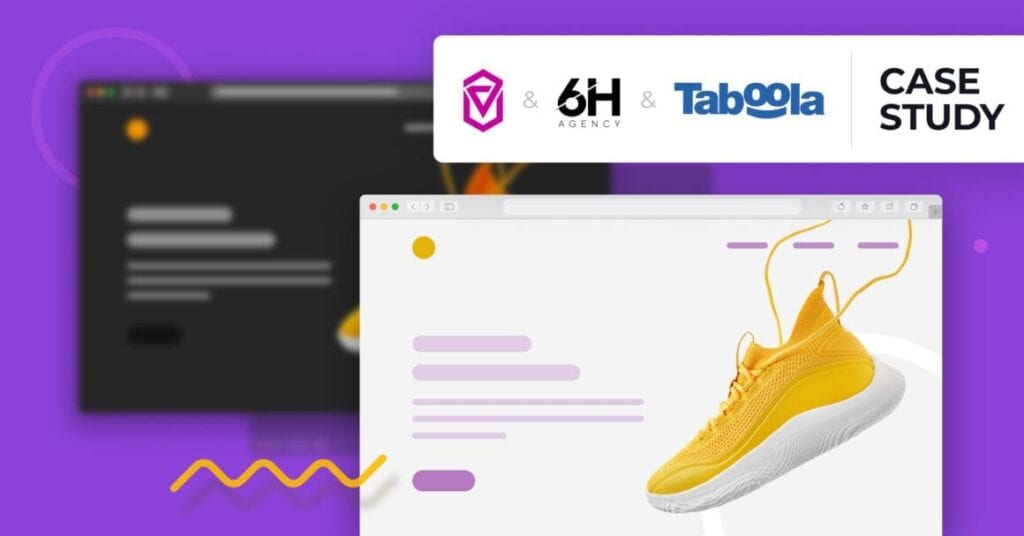
Traffic Distribution AI
A/B testing is one of the main techniques used by marketers to optimize their campaign funnels. It puts the two elements – usually landing pages – that differ in their content or design to the test against each other on the same traffic. If one variant performs better than the other, the majority or all traffic can be directed toward it.
Performance marketers use A/B or multivariate testing on a large scale, sometimes testing even hundreds of landing pages per year. Doing this manually requires an enormous amount of concentration and effort, hence the popularity of Voluum Traffic Distribution AI.
This feature uses machine learning to drive traffic to the most performant offer. The AI learns your traffic throughout the learning period before it makes any changes to the traffic distribution. Once this phase is complete, it redistributes traffic to deliver maximum results while still reacting to any changes and fluctuations of the performance.
Traffic Distribution AI can be applied to:
- Offer & landing pages (separately or combined)
- Paths
Collaboration tools
Although some people still see digital marketers as lone wolves, the truth is that very often there are concrete benefits coming from teaming up and dividing the labor. Not to mention that many marketers decide to form advertising agencies to formalize their cooperation and serve external, bigger customers.
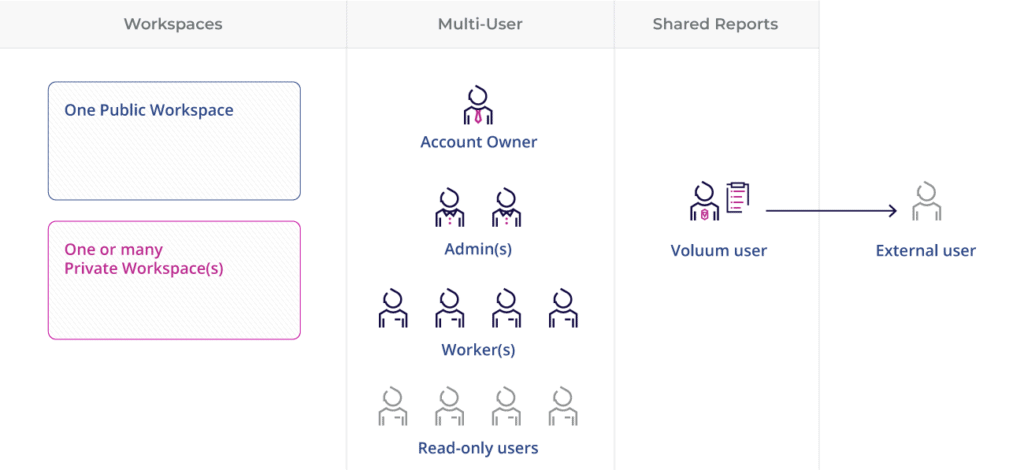
Collaboration tools were designed to facilitate such cases. They allow account owners to segregate their campaign elements into separate work spaces, assign their coworkers to these workspaces with varying levels of access and lastly, create shareable reports that can be viewed by other parties (for example: an agency’s customer) without them needing to log into Voluum.
Workspaces
Voluum by default creates one public work space that is available to all coworkers invited from one Voluum account. Additionally, it allows creating several additional private workspaces that can be viewed by assigned users only. What’s more, you can assign specific domains to private workspaces.
You can also benefit from using workspaces even if you work alone: you can use them for segregating different verticals or offer types. You can choose to view elements only from a given private workspace and filter out the rest at any given time.
Multi-user
Voluum account owners may invite other users and assign them different roles in Voluum. There are 4 role types:
- Account owner – only 1 is available, has the highest level of privilege.
- Admin – has most privileges apart from accessing billing information.
- Worker – a user that can only see, edit or create elements in the public workspace or private workspaces that they were assigned to.
- Read-only user – Similar to Worker but has no create or edit right, they can only view elements from public or assigned private workspaces.
The number of available users depends on your Voluum plan, but you can always add additional users if needed.
Some advertisers, especially those working for customers, may need to share their results with other parties. While you can always export data in the CSV file format, the more elegant way are Shared Reports, which bring some additional benefits.
Shared Reports create a report with data that you can precisely outline. This data is live, meaning that if you choose to create a report with data from the last 7 days, the contents of this report will always be up to date.
The report is accessible to anyone with the link, so there is no need to invite additional users just to show someone your results.
Voluum as a center of campaign management
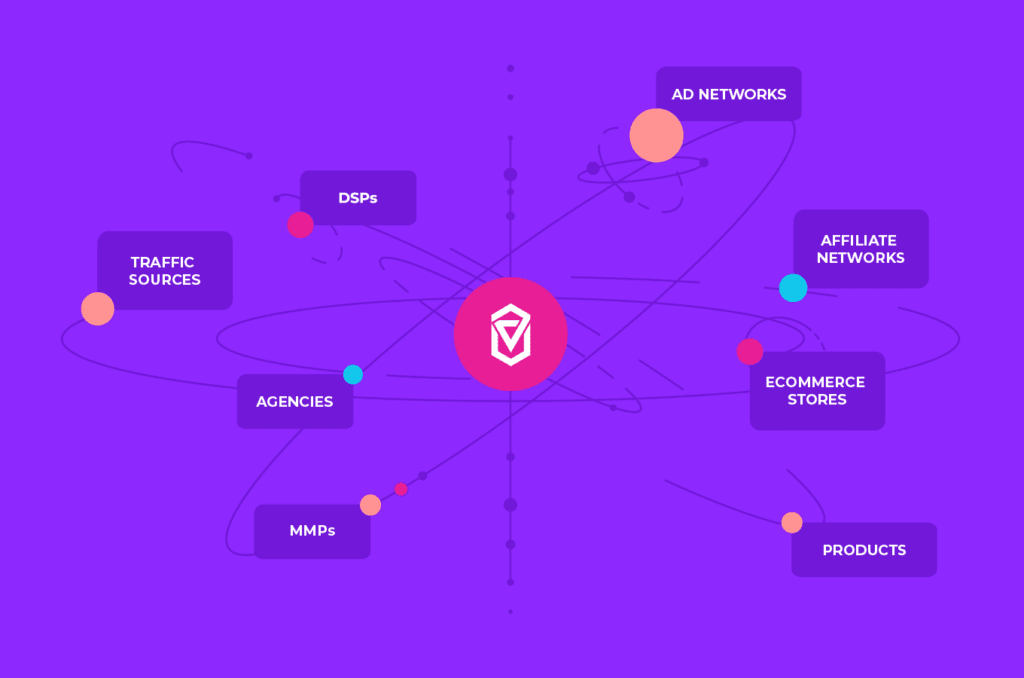
With the current scope of features, we position Voluum as a campaign management dashboard. While marketers more focused on leads may put CRM software in the center of their work and treat Voluum as one of the sources of data, performance marketers can easily do most of their work in Voluum.
The open API integration and option to connect Voluum data streams with other platforms using redirect or direct tracking methods make it a versatile tool for many use cases. You can go through the below list to see how other marketers use Voluum with 3rd party platforms.
Tracking the performance of your partners or affiliates with Voluum
You can use Voluum to track the performance of your partners. Just add them as separate traffic sources in Voluum. This way each partner gets their own campaign link and you can assess how each partner is doing separately. More details are provided in this article.
Some marketers may prefer to use a dedicated tool for that. A great example is presented in the case study where Voluum was used in conjunction with Everflow. Voluum was used to do what it does best: A/B test landing page variations and be the source of insightful reports, while Everflow was used to track the performance of various partners.
Together, they formed a complete solution for running a small business on Amazon.
Tracking your mobile app with Voluum and an MMP
An MMP is a platform designed to track in-app events. These may be:
- In-app purchases
- App installs
- Achieving a certain level in a game or other milestone
MMPs such as AppsFlyer are great in what they do, but what they are missing is the option to view and analyze all marketing efforts in one place. Your app may be advertised somewhere else, or in-app offers may be available to purchase outside said app. That’s why a smart marketer would connect an MMP as one of the sources of data to Voluum.
Voluum is also used by a performance agency offering high-quality in-app traffic.
Voluum solves real-life problems
We tried to demonstrate here that Voluum is a tool built to solve or address specific issues that our clients, digital marketers, have. The growing complexity of the industry makes it hard to make a ‘one-size-fits-all’ solution but we believe that with our approach and the set of features that we have developed throughout the years, we can help the majority of marketers achieve their dream goals.
If your needs are more specific or you have some additional questions, you can contact our sales team and they will happily answer all your concerns. Talking doesn’t cost you anything and we highly encourage you to reach us, so we can learn about your case.
If you are already set on using Voluum, grab it and start advertising.
For additional learning resources you can visit:
- Affiliate Academy that offers an extensive introduction to affiliate marketing
- Webinar section that offers recordings of old webinars and information about upcoming new ones
- Voluum knowledge base with documents describing all Voluum features in details
- Voluum blog for the latest information and insights regarding the industry

